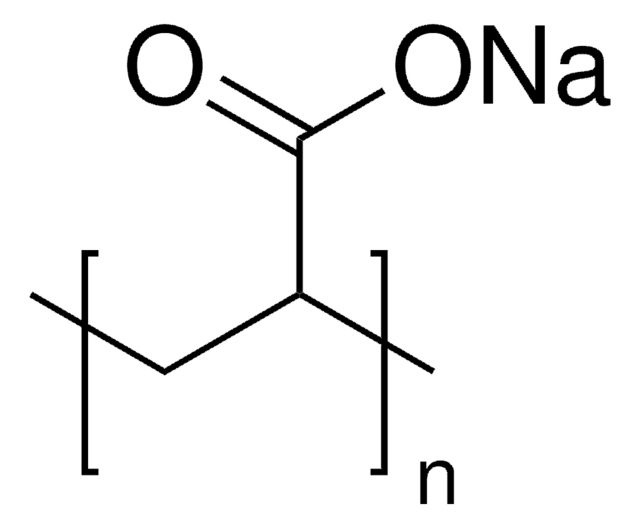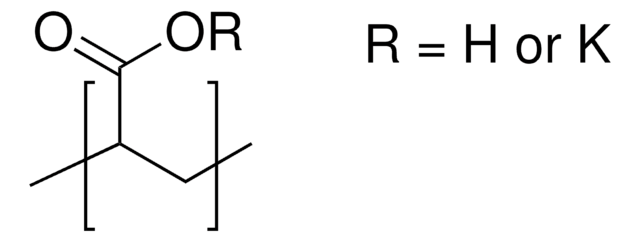All Photos(3)
About This Item
Linear Formula:
(C3H4O2)n
CAS Number:
MDL number:
UNSPSC Code:
12162002
PubChem Substance ID:
NACRES:
NA.23
Recommended Products
crosslinking
~0.1 % cross-linked
Quality Level
mol wt
average Mv ~3,000,000
viscosity
30,000-40,000 cP
transition temp
Tg 106 °C
InChI
1S/C3H4O2.Na/c1-2-3(4)5;/h2H,1H2,(H,4,5);/q;+1/p-1
InChI key
NNMHYFLPFNGQFZ-UHFFFAOYSA-M
Looking for similar products? Visit Product Comparison Guide
Related Categories
Application
- IR and Raman investigation of some poly(acrylic) acid gels in aqueous and neutralized state: This study explores the modification of local polymeric conformation of poly(acrylic) acid (PAA), induced by hydration and neutralization with triethanolamine, using IR and Raman spectroscopy. (M Todica et al., 2015).
- Phase Behavior of Aqueous Poly(acrylic acid-g-TEMPO): Research on poly(acrylic acid) grafted with TEMPO moieties, focusing on phase separation behavior over different pH ranges, which could be relevant for creating responsive materials. (Q Fu et al., 2016).
- Synthesis and characterization of poly(glyceric acid carbonate): a degradable analogue of poly(acrylic acid): This article presents a degradable analogue to poly(acrylic acid) and compares the properties of hydrogels prepared from this new polymer with those from PAA, relevant for biomedical applications. (H Zhang et al., 2015).
- Mechanically stable thermally crosslinked poly(acrylic acid)/reduced graphene oxide aerogels: Study on enhancing the mechanical integrity of reduced graphene oxide aerogels by intermixing with thermally cross-linkable PAA, pertinent to material science. (H Ha et al., 2015).
- Polyacrylic acid polymers hydrogels intended for topical drug delivery: preparation and characterization: Investigates the bioadhesiveness of polyacrylic acid polymers in hydrogels, emphasizing their potential in designing topical drug delivery systems. (G Calixto et al., 2015).
Signal Word
Danger
Hazard Statements
Precautionary Statements
Hazard Classifications
Carc. 1A - Muta. 1B
Storage Class Code
6.1C - Combustible acute toxic Cat.3 / toxic compounds or compounds which causing chronic effects
WGK
WGK 3
Flash Point(F)
Not applicable
Flash Point(C)
Not applicable
Choose from one of the most recent versions:
Already Own This Product?
Find documentation for the products that you have recently purchased in the Document Library.
Customers Also Viewed
Laurence Glennon-Alty et al.
Acta biomaterialia, 9(4), 6041-6051 (2012-12-15)
Mesenchymal stem cells (MSCs) can generate chondrocytes in vitro, but typically need to be cultured as aggregates in the presence of transforming growth factor beta (TGF-β), which makes scale-up difficult. Here we investigated if polyacrylate substrates modelled on the functional
Yanxia Wang et al.
International journal of pharmaceutics, 441(1-2), 170-180 (2012-12-15)
A novel galactose-decorated cross-linked micelles (cl-micelles) with ionic cores using cystamine (Cys) as a biodegradable cross-linker was prepared by using block ionomer complexes of poly(ethylene glycol)-b-poly(2-acryloxyethyl-galactose)-b-poly(acrylic acid) (PEG-b-PAEG-b-PAA) and Ca(2+) (PEG-b-PAEG-b-PAA cl-micelles/Cys). Doxorubicin (DOX) was successfully incorporated into the ionic
Daniel L Miller et al.
The Annals of thoracic surgery, 95(3), 1050-1056 (2013-01-22)
Skeletal chest wall reconstruction can be a challenge, depending on the indication, location, and health of the patient; various materials are available. Recently, biomaterials that are remodelable (bovine pericardium patch; Veritas, Synovis Life Technologies Inc, St Paul, MN) or absorbable
Chunjiao Zhou et al.
Journal of nanoscience and nanotechnology, 13(7), 4627-4633 (2013-08-02)
Poly(acrylic acid) (PAA) coated-Fe3O4 superparamagnetic nano-composites were synthesized through a solvothermal technique by using cheap and environmental friendly iron salts and PAA. Each nano-composite was composed of many small primary nanocrystals. The as-synthesized products were characterized by X-ray diffraction (XRD)
Serhat Elcicek et al.
Experimental parasitology, 133(3), 237-242 (2012-12-15)
Polyacrylic acid (PAA) is one of the anionic synthetic polyelectrolytes and is used in various immunological and pharmaceutical applications. PAA has been used as adjuvant in veterinary vaccines, in particular. However, to our knowledge, there are no studies that document
Our team of scientists has experience in all areas of research including Life Science, Material Science, Chemical Synthesis, Chromatography, Analytical and many others.
Contact Technical Service



